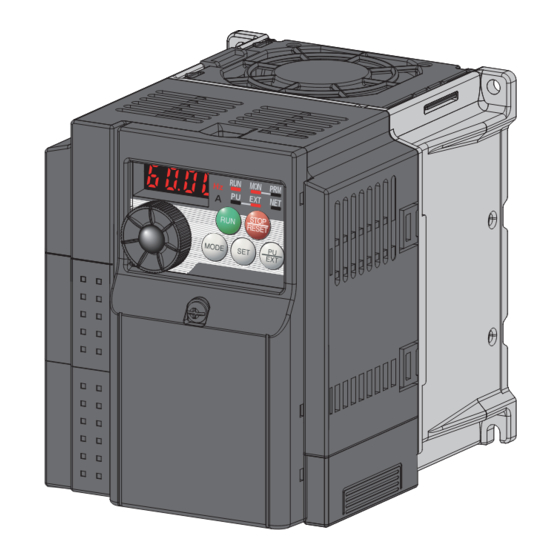
Table of Contents
Advertisement
Advertisement
Table of Contents

Summarization of Contents
OUTLINE
Product checking and parts identification
Instructions for unpacking and verifying the inverter model and components against the order and ensuring the product is intact.
Inverter and peripheral devices
Overview of the inverter unit and its associated peripheral devices, including power supplies, contactors, and filters.
Removal and reinstallation of the cover
Detailed procedures for safely removing and reinstalling the front and wiring covers of the inverter unit.
Installation of the inverter and enclosure design
Guidelines for designing and manufacturing enclosures, considering heat generation, environment, and equipment layout for optimal reliability.
WIRING
Terminal connection diagram
Diagram illustrating the connections for main circuit, control circuit, frequency setting, and safety stop signals.
Main circuit terminal specifications
Detailed specifications for main circuit terminals, including AC power input, inverter output, and connections for brake units and reactors.
Control circuit specifications
Details on control circuit terminals, including input signals, output signals, communication, and safety stop function.
Connection of stand-alone option unit
Instructions for connecting optional units like brake resistors, brake units, power factor converters, and DC reactors.
PRECAUTIONS FOR USE OF THE INVERTER
EMC and leakage currents
Measures to suppress electromagnetic interference and leakage currents, including selection of breakers and filters.
Installation of power factor improving reactor
Guidance on installing AC reactors to prevent excessive peak current flow in the power input circuit.
Power-OFF and magnetic contactor (MC)
Recommendations for using magnetic contactors on the inverter input side for safety and maintenance.
Inverter-driven 400V class motor
Measures to address surge voltage issues when driving 400V class motors, including motor insulation and carrier frequency.
Precautions for use of the inverter
General safety precautions for handling, wiring, and operating the inverter to prevent damage or injury.
Failsafe of the system which uses the inverter
Methods for implementing failsafe systems using inverter status signals and backup methods outside the inverter.
PARAMETERS
Operation panel
Detailed explanation of the names and functions of the operation panel keys, indicators, and displays.
Parameter list
Comprehensive list of all inverter parameters, their functions, setting ranges, initial values, and references.
Adjustment of the output torque (current) of the motor
Methods for adjusting motor torque, including manual torque boost, slip compensation, and stall prevention.
Limiting the output frequency
Settings for maximum, minimum, and high-speed output frequencies, and avoiding mechanical resonance points.
V/F pattern
Configuration of V/F patterns, including base frequency, voltage settings, and load pattern selection.
Frequency setting by external terminals
Methods for setting frequency using external terminals, including multi-speed operation, jog operation, and remote setting.
Setting of acceleration/deceleration time and acceleration/deceleration pattern
Adjusting acceleration and deceleration times, and selecting S-pattern or linear acceleration/deceleration.
Selection and protection of a motor
Guidelines for selecting motors and configuring motor protection features like overheat and stall prevention.
Motor brake and stop operation
Configuration of DC injection brake, regenerative braking, and various motor stop methods.
Function assignment of external terminal and control
Mapping input and output terminal functions for start signals, speed commands, and status monitoring.
Monitor display and monitor output signal
Configuration of operation panel display, PU monitor, and terminal FM output signals for various parameters.
Operation selection at power failure and instantaneous power failure
Settings for automatic restart and power failure deceleration stop functions to ensure continuous operation.
Operation setting at fault occurrence
Configuration of retry functions, phase loss protection, and earth fault detection to manage fault conditions.
Energy saving operation
Optimization settings for energy saving, including optimum excitation control and cooling fan operation.
Motor noise, EMI measures, mechanical resonance
Techniques to reduce motor noise, EMI, and mechanical resonance using PWM carrier frequency and speed smoothing.
Frequency setting by analog input (terminal 2, 4)
Configuration of analog inputs for frequency setting, including selection, bias, and gain adjustment.
Misoperation prevention and parameter setting restriction
Settings to prevent misoperation, such as reset selection, parameter write disable, and password protection.
Selection of operation mode and operation location
Options for selecting operation modes (PU, External, Network) and controlling the inverter via various sources.
Communication operation and setting
Configuration for communication with computers via PU connector, including RS-485 and MODBUS RTU protocols.
TROUBLESHOOTING
Reset method of protective function
Procedures for resetting protective functions, including clearing internal thermal values and retry counts.
List of fault or alarm indications
A comprehensive list of operation panel indications for faults and alarms, with corresponding names and page references.
Causes and corrective actions
Detailed troubleshooting guide for error messages, warnings, and faults, including possible causes and corrective actions.
Correspondences between digital and actual characters
Mapping between digital characters displayed on the operation panel and their actual alphanumeric representations.
Check first when you have a trouble
Initial checks and troubleshooting steps for common issues like motor not starting or abnormal noise.
PRECAUTIONS FOR MAINTENANCE AND INSPECTION
Inspection items
Daily and periodic inspection guidelines to prevent faults due to environmental factors and part deterioration.
Measurement of main circuit voltages, currents and powers
Methods for measuring voltages, currents, and powers on the inverter's input and output sides using various instruments.
SPECIFICATIONS
Rating
Technical specifications including applicable motor capacity, rated capacity, current, voltage, and braking torque.
Common specifications
General specifications covering control methods, frequency ranges, input/output signals, protective functions, and environmental conditions.
Outline dimension drawings
Detailed physical dimensions and mounting information for the inverter and optional units.
















Need help?
Do you have a question about the FR-D720S K Series and is the answer not in the manual?
Questions and answers